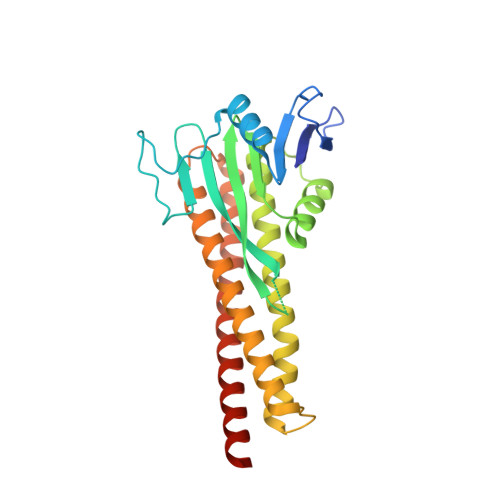Structural and biochemical analysis of the unique interactions of the Campylobacter jejuni CorA channel protein with divalent cations.
Ahn, S.Y., Lee, S.J., Yoon, S.I.(2024) Biochem Biophys Res Commun 723: 150166-150166
- PubMed: 38810321
- DOI: https://doi.org/10.1016/j.bbrc.2024.150166
- Primary Citation of Related Structures:
8ZAH, 8ZAK - PubMed Abstract:
CorA is a Mg 2+ channel that plays a key role in the homeostasis of intracellular Mg 2+ in bacteria and archaea. CorA consists of a cytoplasmic domain and a transmembrane domain and generates a Mg 2+ pathway by forming a pentamer in the cell membrane. CorA gating is regulated via negative feedback by Mg 2+ , which is accommodated by the pentamerization interface of the CorA cytoplasmic domain (CorA CD ). The Mg 2+ -binding sites of CorA CD differ depending on the species, suggesting that the Mg 2+ -binding modes and Mg 2+ -mediated gating mechanisms of CorA vary across prokaryotes. To define the Mg 2+ -binding mechanism of CorA in the Campylobacter jejuni pathogen, we structurally and biochemically characterized C. jejuni CorA CD (cjCorA CD ). cjCorA CD adopts a three-layered α/β/α structure as observed in other CorA orthologs. Interestingly, cjCorA CD exhibited enhanced thermostability in the presence of Ca 2+ , Ni 2+ , Zn 2+ , or Mn 2+ in addition to Mg 2+ , indicating that cjCorA CD interacts with diverse divalent cations. This cjCorA CD stabilization is mediated by divalent cation accommodation by negatively charged residues located at the bottom of the cjCorA CD structure away from the pentamerization interface. Consistently, cjCorA CD exists as a monomer irrespective of the presence of divalent cations. We concluded that cjCorA CD binds divalent cations in a unique pentamerization-independent manner.
Organizational Affiliation:
Division of Biomedical Convergence, College of Biomedical Science, Kangwon National University, Chuncheon, 24341, Republic of Korea.















